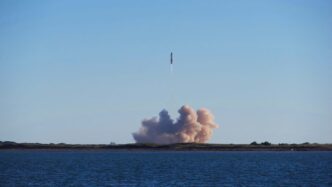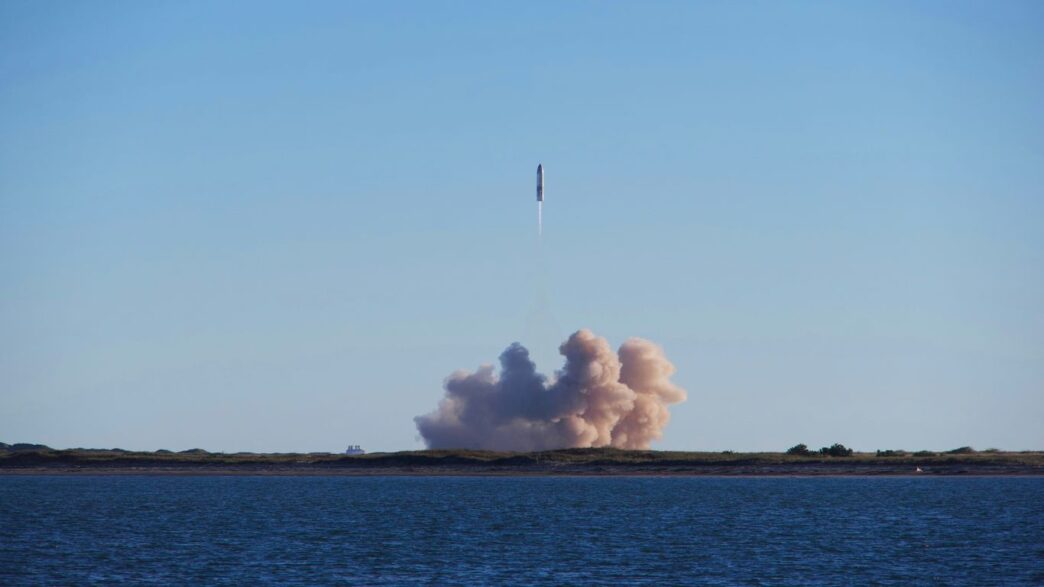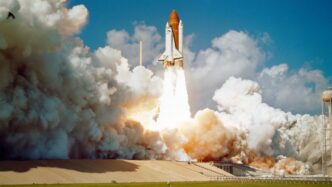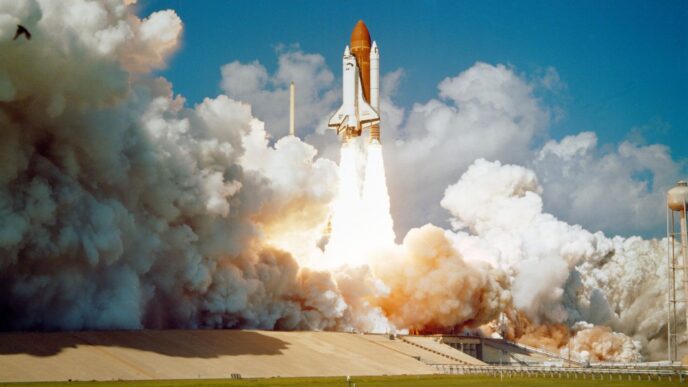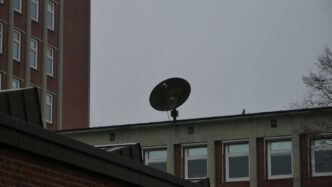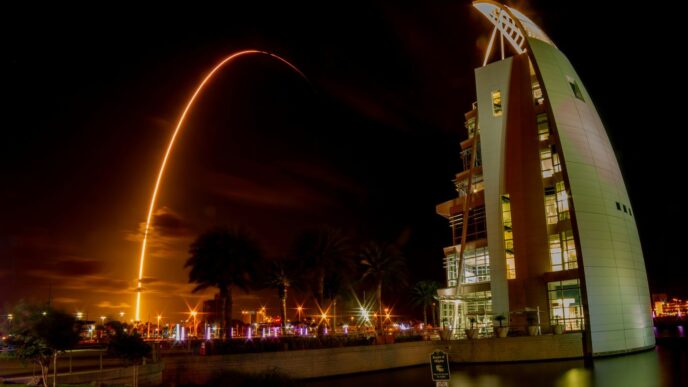SpaceX is gearing up for another trip to the International Space Station (ISS) with the Crew-8 mission. This mission sends a new group of astronauts up for a stay on the orbiting lab. It’s part of NASA’s ongoing effort to use commercial partners for getting astronauts to space. Let’s look at who’s going and what they’ll be doing.
Key Takeaways
- The Crew-8 mission features a four-person crew: NASA astronauts Matthew Dominick (commander), Michael Barratt (pilot), and Jeanette Epps (mission specialist), along with Roscosmos mission specialist Alexander Grebenkin.
- The launch uses a SpaceX Falcon 9 rocket and the Crew Dragon Endeavour spacecraft, departing from Kennedy Space Center in Florida.
- After launch, the Crew-8 astronauts will travel to the ISS for a mission lasting about six months, during which they will conduct over 200 scientific experiments.
- The Crew Dragon Endeavour spacecraft making its fifth flight, has a history of carrying astronauts for NASA, including the first crewed flight, Demo-2.
- Launch dates and times for the Crew-8 mission have been subject to adjustments based on weather and operational readiness, with backup opportunities planned.
Meet The Crew-8 Astronauts
Alright, let’s talk about the folks heading up to the International Space Station on this SpaceX Crew-8 mission. It’s always pretty cool to see who’s going to be living and working up there for a while. This particular crew is a mix of seasoned space travelers and first-timers, which is always an interesting dynamic.
Commander Matthew Dominick
Commander Dominick is a U.S. Navy test pilot and joined NASA’s astronaut corps back in 2017. This trip marks his very first time venturing into space. He’s in charge of the whole operation, making sure everything runs smoothly from the commander’s seat.
Pilot Michael Barratt
Now, Michael Barratt is a bit of a veteran. He’s a physician by training and has actually been part of the astronaut program since 2000. This isn’t his first rodeo in space; he’s been up there before for a six-month stint and also flew on a Space Shuttle mission. He’ll be handling the piloting duties for the Crew Dragon.
Mission Specialist Jeanette Epps
Jeanette Epps is a mission specialist and this will be her first spaceflight too. She’s got a background in physics and aerospace engineering, and before becoming an astronaut, she worked at places like the Ford Motor Company and even the CIA. She’s been involved with NASA operations from the ground, working on crew efficiency and communications, so she’s definitely got the right stuff for this mission.
Mission Specialist Alexander Grebenkin
Rounding out the crew is Alexander Grebenkin, who comes to us from the Russian space agency, Roscosmos. He’s also a mission specialist. Grebenkin has a background as a pilot in the Russian Air Force and holds engineering degrees related to aircraft systems. This is his first journey to space as well.
It’s a solid team, ready to tackle the science and operations aboard the ISS. Each member brings a unique set of skills and experiences to the table, making them well-prepared for their time in orbit.
The Crew-8 Mission Launch Details
Getting astronauts to the International Space Station (ISS) is a pretty big deal, and for Crew-8, it all starts with a powerful ride.
Launch Vehicle: SpaceX Falcon 9 and Crew Dragon Endeavour
This mission is using a tried-and-true combo: the SpaceX Falcon 9 rocket and the Crew Dragon Endeavour spacecraft. The Falcon 9 is the workhorse rocket that gets everything off the ground, and Endeavour is the capsule that carries the astronauts safely to orbit. It’s pretty cool that Endeavour has flown astronauts before, including the very first crewed flight for NASA back in 2020. This will be its fifth trip to space.
Launch Site: Kennedy Space Center, Florida
All the action kicks off from NASA’s Kennedy Space Center in Florida. It’s a classic launch spot for a reason, with all the facilities needed to get a mission like this off the ground. The specific pad used is Pad 39A.
Launch Window Considerations
Launching a rocket isn’t quite as simple as just picking a day. There are specific times, called launch windows, when everything has to line up perfectly for the spacecraft to reach its destination. For Crew-8, this meant they had to hit an exact moment, or an "instantaneous window." If they miss it, they have to wait for the next opportunity. Weather is a big factor here; things like high winds or rain can push a launch back. The Crew-8 mission actually had a few delays before it finally took off, mostly due to weather conditions along the flight path.
How To Watch The Crew-8 Launch Live
If you want to see this kind of thing happen, you’re in luck! SpaceX and NASA usually provide livestreams online. You can catch the launch on platforms like NASA TV’s YouTube channel. It’s a great way to witness history from your own home. The launch itself is pretty quick, with the rocket lifting off and the Dragon capsule separating from the rocket in just a matter of minutes.
Journey To The International Space Station

After blasting off from Florida, the Crew-8 astronauts have a journey ahead of them to reach the International Space Station (ISS). It’s not just a quick hop; it’s a carefully orchestrated trip that takes time and precision.
Docking Procedures With The ISS
Getting to the ISS is one thing, but actually attaching to it is another challenge entirely. The Crew Dragon spacecraft, guided by its onboard systems and ground control, approaches the station slowly and deliberately. There are specific docking ports on the ISS, and the spacecraft needs to align perfectly. It’s a bit like threading a needle, but in space! Once aligned, robotic arms and latches engage to create a secure connection. This docking process is a critical step, marking the official start of their time aboard the orbiting laboratory.
Duration Of The Crew-8 Mission
So, how long will the Crew-8 astronauts be living and working in space? For this mission, the plan is for a stay of about six months. This is a pretty standard duration for astronaut missions to the ISS, allowing them ample time to conduct their research and support station operations. It’s a significant chunk of time away from home, spent in a unique environment, contributing to science and exploration.
Scientific Endeavors Aboard The ISS
The Crew-8 mission isn’t just about getting to space; it’s about what the astronauts will do there. They’re heading up with a packed schedule, aiming to conduct over 200 different scientific experiments and technology tests. Think of the International Space Station (ISS) as a unique lab, one that lets us study things we just can’t replicate down here on Earth.
Over 200 Scientific Experiments Planned
This isn’t just a few small tests. The crew will be busy with a wide range of research. Some of it is about understanding how the human body handles long periods in space, which is super important if we ever want to send people on longer trips, like to Mars. They’ll be looking at things like bone density loss, muscle changes, and even how our eyes react to microgravity.
Here’s a peek at the kinds of research areas:
- Human Health: Studying the effects of space on the body to help future astronauts and people on Earth.
- Materials Science: Testing how different materials behave in space, which could lead to new products.
- Biology: Growing plants and studying microorganisms in microgravity.
- Physics: Observing phenomena that are hard to see or measure in a gravity-filled environment.
Research Supporting Future Exploration
Many of these experiments have a direct link to the future of space travel. NASA and its partners are always looking for ways to make space missions safer and more efficient. The data gathered by the Crew-8 astronauts will help design better spacecraft, develop countermeasures for the health challenges of spaceflight, and figure out how humans can live and work sustainably beyond Earth. It’s all about paving the way for the next giant leaps in space exploration. They’re not just astronauts; they’re also scientists contributing to our growing knowledge of the universe and our place within it.
SpaceX’s Role In The Crew-8 Voyage
SpaceX is the company behind the rocket and spacecraft that get our astronauts to the International Space Station for the Crew-8 mission. They’ve really become a go-to for getting people into orbit.
The Crew Dragon Endeavour Spacecraft
The Crew Dragon capsule, named Endeavour for this mission, is what the astronauts actually sit in for the trip. It’s designed to carry up to seven people, but for these NASA missions, they usually fly with four. Endeavour isn’t new to this; Crew-8 is actually its fifth flight. It’s been used for other NASA crews before, like Crew-2 and Crew-6, and even for private trips. This capsule is a key piece of technology that makes these regular trips to space possible.
Falcon 9 Rocket Performance
Getting the Crew Dragon into space requires a powerful rocket, and that’s where the Falcon 9 comes in. This rocket is SpaceX’s workhorse. For the Crew-8 launch, it’s expected to perform its usual routine: lift off, send the Dragon capsule on its way, and then the first stage of the rocket will try to land itself back on Earth. This landing is so SpaceX can reuse the rocket for future missions, which helps keep costs down.
Here’s a look at what happens during a typical Falcon 9 launch:
- Liftoff: The rocket ignites its engines and leaves the launch pad.
- Stage Separation: After burning its fuel, the first stage separates from the second stage.
- Booster Landing: The first stage fires small engines to slow down and land vertically.
- Second Stage Burn: The second stage continues to push the spacecraft towards orbit.
Previous Missions Of The Endeavour Capsule
As mentioned, the Endeavour capsule has flown a few times before. It was actually used for the very first crewed flight SpaceX did for NASA, called Demo-2, back in May 2020. Since then, it’s been on several other important missions:
- Demo-2: The initial test flight with astronauts.
- Crew-2: Another NASA astronaut mission.
- Crew-6: A more recent NASA astronaut mission.
- Axiom Mission 1 (Ax-1): A private astronaut mission.
So, by the time Crew-8 launches, Endeavour has a good track record of getting astronauts safely to and from space.
Crew-8 Mission Milestones And Contingencies
Launching a space mission isn’t always a simple ‘set it and forget it’ kind of deal. There are a lot of moving parts, and sometimes, things just don’t go according to the initial plan. The Crew-8 mission, like any complex spaceflight, had its own set of potential hiccups and backup plans.
Launch Delays And Weather Impacts
Weather is a big one, obviously. You can’t just blast off if there are high winds or storms brewing around the launch site or along the rocket’s flight path. For Crew-8, there were a few days where the weather just wasn’t cooperating. Initially, the launch was planned for March 1st, but offshore weather conditions pushed it back. Then, it was delayed again to March 3rd for similar reasons. These delays aren’t just minor inconveniences; they require careful rescheduling of ground operations and can impact the mission’s overall timeline.
Here’s a look at how the launch window shifted:
- Original Target: Early March 1st
- First Delay: Late March 1st (due to offshore weather)
- Second Delay: March 3rd (due to unfavorable flight path conditions)
It’s a delicate dance, balancing the desire to get the astronauts to the International Space Station (ISS) with the absolute necessity of a safe launch.
Backup Launch Opportunities
When a launch gets delayed, it’s not like you can just try again an hour later. There are specific launch windows that need to be met for the spacecraft to reach its destination efficiently. If the primary window is missed, mission control looks at the next available opportunities.
For Crew-8, NASA and SpaceX had a few backup dates lined up:
- Backup 1: March 1st, late evening
- Backup 2: March 2nd, late morning
- Backup 3: March 4th, evening (added after the March 3rd target)
These backup windows are critical. They provide flexibility and ensure that the mission can still proceed even if the initial launch attempt is scrubbed. It’s all about having a plan B, and sometimes, a plan C, to make sure the astronauts get to space safely and on schedule, as much as possible.
Looking Ahead
So, the Crew-8 mission is officially underway, sending another team of astronauts to the International Space Station. It’s pretty amazing to think about what they’ll be doing up there for the next six months, running experiments and just generally living in space. This flight, like so many before it, shows how far we’ve come with space travel, thanks to companies like SpaceX and the hard work of NASA. It’s a big step, and we’ll be watching to see what they accomplish. Hopefully, everything goes smoothly for them, and they make it back safe and sound.
Frequently Asked Questions
Who are the astronauts on the Crew-8 mission?
The Crew-8 mission has four astronauts: NASA’s Matthew Dominick, who is the commander, and Michael Barratt, the pilot. Jeanette Epps, also from NASA, is a mission specialist. The fourth member is Alexander Grebenkin, a mission specialist from the Russian space agency, Roscosmos.
What rocket and spacecraft are used for the Crew-8 mission?
SpaceX’s powerful Falcon 9 rocket carries the Crew Dragon spacecraft, named Endeavour, to space for the Crew-8 mission. This is a reliable combination that SpaceX has used for many astronaut trips.
Where does the Crew-8 mission launch from?
The Crew-8 astronauts blast off from NASA’s Kennedy Space Center in Florida. This location is a famous launch site for many space missions.
How long will the astronauts be in space?
The Crew-8 astronauts are planned to stay on the International Space Station for about six months. During this time, they will live and work in orbit.
What will the astronauts do on the International Space Station?
The crew will conduct over 200 science experiments and technology tests. These studies help us learn more about space and prepare for future missions, like traveling to the Moon and Mars.
What happens if the launch needs to be delayed?
Space missions can be delayed due to weather or technical checks. If the Crew-8 mission can’t launch at the first scheduled time, there are backup dates and times available. NASA and SpaceX will choose the safest time to launch.

